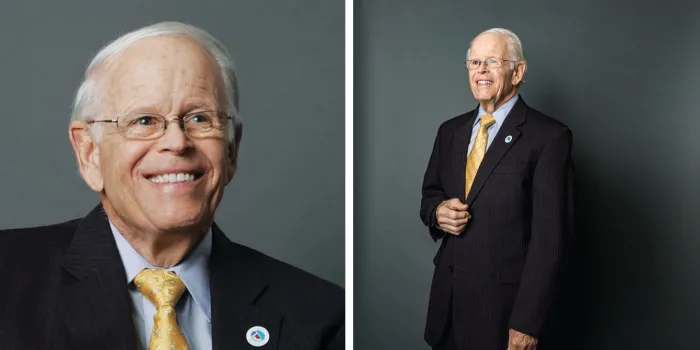Growing up in Southern California, James V. Luck Jr., MD, heard inspiring—and hair-raising—family stories about orthopedic surgery. In 1911, Luck’s grandmother had her lower leg amputated on the kitchen table by a young surgeon and an anesthesiologist after her own physician refused to perform the risky procedure.
“She had tuberculosis of the bone. The amputation removed it, and she lived a very long, active life,” Luck says. Decades later, Luck’s father, the late orthopedic surgeon J. Vernon Luck Sr., MD, made history when he performed the first known major elective surgery, a hip replacement, on a person with a bleeding disorder.
Courage, innovation and the willingness to take well-informed, calculated risks define these stories. But Luck, age 78, says it’s the teamwork behind the procedures that inspired his decision to specialize in orthopedic surgery for people with bleeding disorders.
“Being part of a capable, multidisciplinary group dealing with a complex and challenging disorder really gets me excited, and that’s hemophilia in a nutshell,” says Luck, director of surgical services and rehabilitation at the Orthopaedic Hemophilia Treatment Center in Los Angeles and a professor in residence of orthopedic surgery at the David Geffen School of Medicine at UCLA. “For successful surgery, you need hematologists, specialized nurses, physician assistants, physical therapists, social workers and more. And of course, the patient is an integral part of the team. Working with all of these people is very gratifying to me.”
Luck studied medicine at the University of Southern California and then served in the United States Air Force before joining the Orthopaedic Institute for Children Hemophilia Treatment Center in 1968. Clotting factor was just being introduced into the OR, transforming surgery. “Bleeding disorders led to severe joint pain, disability and a life expectancy of about age 50 then,” says Luck. “Today, people with bleeding disorders have normal life spans. Joint reconstruction, if needed, allows them to lead full lives—working, picking up their children, exercising, enjoying themselves. The change is immense.”
Luck tracks his patients throughout their lives. “As a physician, I’m concerned about them,” he says. “As a researcher, I wanted to see what was happening, what worked and where we could improve.” In 1985, he co-authored one of the first reviews on managing bleeding in elective and emergency surgery in people with hemophilia, in the Journal of the American Medical Association.
Luck became a world leader in the research and treatment of hemophiliac arthrofibrosis, fibrous tissue that leads to joint pain and immobility, affecting 50% to 90% of people with hemophilia. In a 2016 paper in the journal Haemophilia, he and a team identified a possible cause: connective tissue growth factor. The finding could lead to early warning tests for the condition. Luck also led a recent study that tracks the long-term success of hip replacement joints featuring a new material called highly cross-linked polyethylene, which was developed in the J. Vernon Luck Sr., MD, Biomechanics Laboratory at the Orthopaedic Hospital, now the Orthopaedic Institute for Children. “Surgeons all over the world were noticing that replacement joints wore out sooner in people with hemophilia,” he says. “The new joints are wearing very well, with no added risk for infections or reoperation.”
People with hemophilia have always been important members of the treatment team for Luck. In an abstract presented at the World Federation of Hemophilia World Congress in 2018, they took center stage. In a study about preventing infection after joint replacement, his team found that people who learned sterile techniques for self-infusion of factor reduced late infection rates from 17% to zero. Good news, because treatment for a late infection after surgery requires removing the joint, resolving the infection and replacing the joint.
Luck says being part of the advancements in the care of people with bleeding disorders is deeply gratifying. “So many people are devoted to this effort, doing everything they can—working with patients, doing research, going to meetings to learn more from each other,” he says. “To see our ability to treat and dramatically improve outcomes for people throughout the years has been wonderful. And it continues.”

